Content Theories of Motivation: Theories and Criticisms Examined
VerifiedAdded on 2020/05/16
|25
|6736
|64
Essay
AI Summary
This paper provides a comprehensive overview of content theories of motivation, focusing on the contributions of Maslow, Herzberg, and McGregor. It begins by differentiating content theories from process theories, establishing a framework for understanding the internal factors that drive employee behavior. The paper then delves into Maslow's hierarchy of needs, explaining its levels and implications for workplace motivation, alongside criticisms of its assumptions. Herzberg's two-factor theory is examined, with an analysis of its impact on job satisfaction and dissatisfaction. Finally, the paper explores McGregor's Theory X and Theory Y, contrasting management styles and their effects on employee performance. The paper also includes criticisms of each theory, offering a balanced perspective on their practical application in organizational settings and their contribution to the field of management.
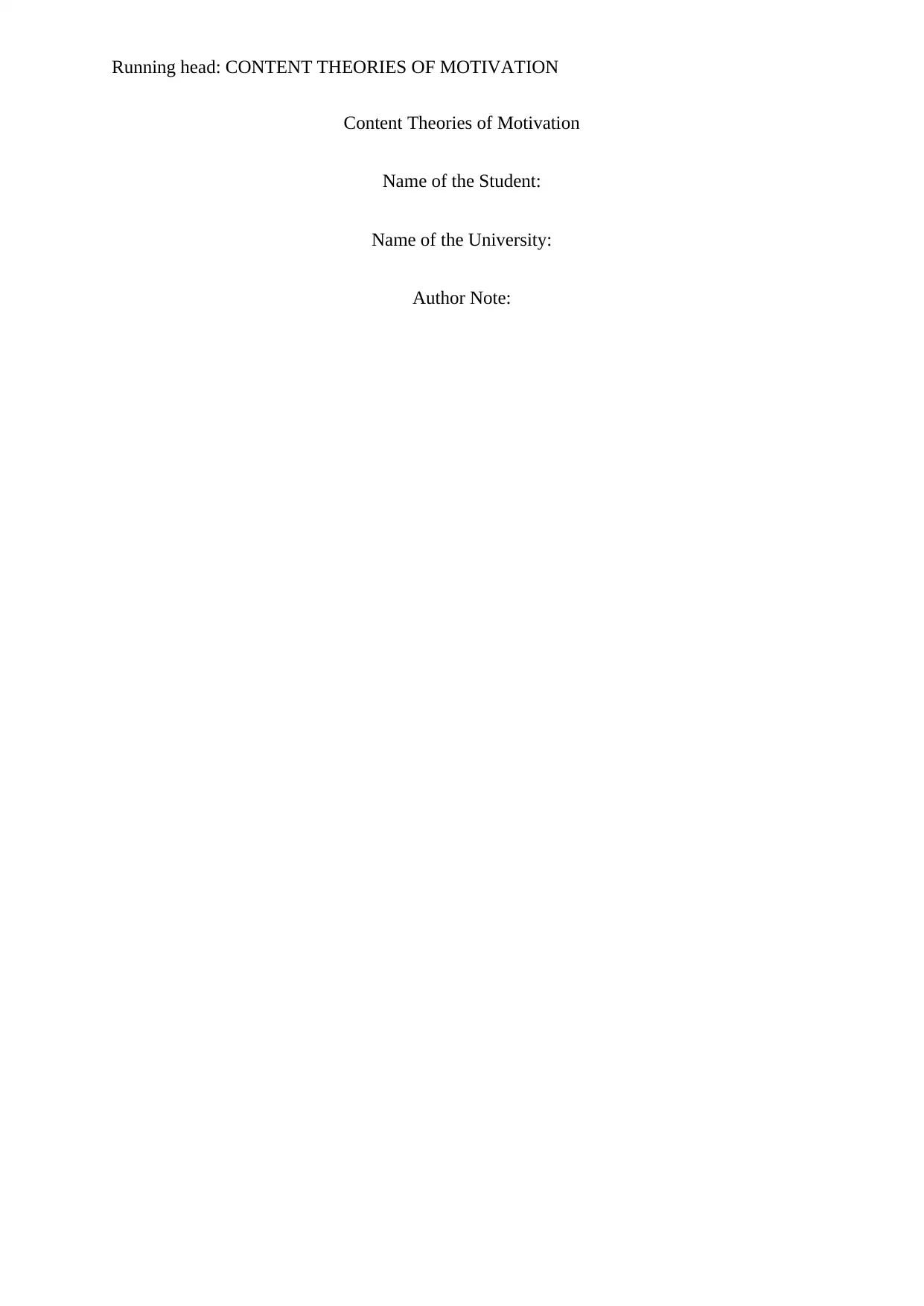
Running head: CONTENT THEORIES OF MOTIVATION
Content Theories of Motivation
Name of the Student:
Name of the University:
Author Note:
Content Theories of Motivation
Name of the Student:
Name of the University:
Author Note:
Paraphrase This Document
Need a fresh take? Get an instant paraphrase of this document with our AI Paraphraser
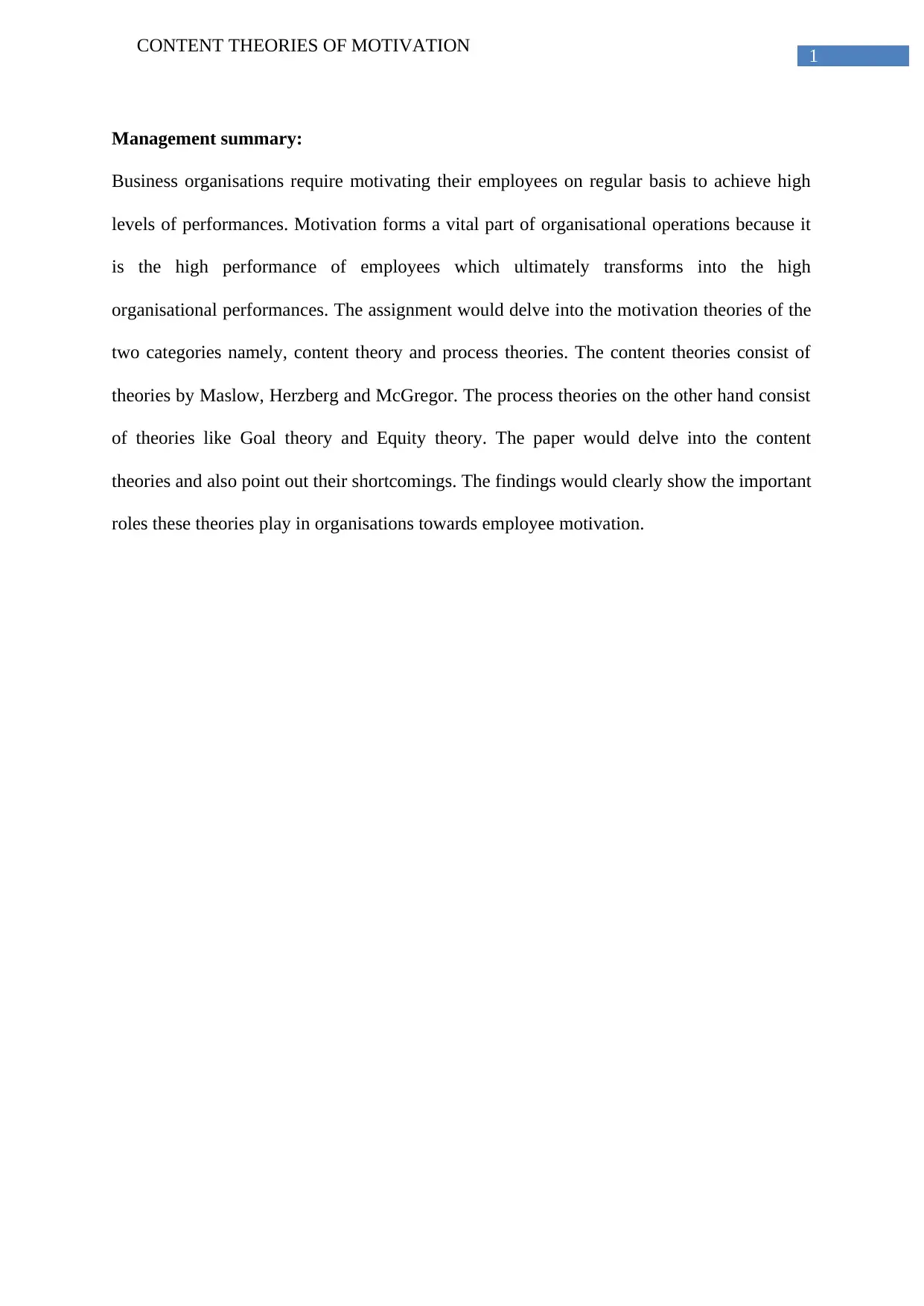
1
CONTENT THEORIES OF MOTIVATION
Management summary:
Business organisations require motivating their employees on regular basis to achieve high
levels of performances. Motivation forms a vital part of organisational operations because it
is the high performance of employees which ultimately transforms into the high
organisational performances. The assignment would delve into the motivation theories of the
two categories namely, content theory and process theories. The content theories consist of
theories by Maslow, Herzberg and McGregor. The process theories on the other hand consist
of theories like Goal theory and Equity theory. The paper would delve into the content
theories and also point out their shortcomings. The findings would clearly show the important
roles these theories play in organisations towards employee motivation.
CONTENT THEORIES OF MOTIVATION
Management summary:
Business organisations require motivating their employees on regular basis to achieve high
levels of performances. Motivation forms a vital part of organisational operations because it
is the high performance of employees which ultimately transforms into the high
organisational performances. The assignment would delve into the motivation theories of the
two categories namely, content theory and process theories. The content theories consist of
theories by Maslow, Herzberg and McGregor. The process theories on the other hand consist
of theories like Goal theory and Equity theory. The paper would delve into the content
theories and also point out their shortcomings. The findings would clearly show the important
roles these theories play in organisations towards employee motivation.
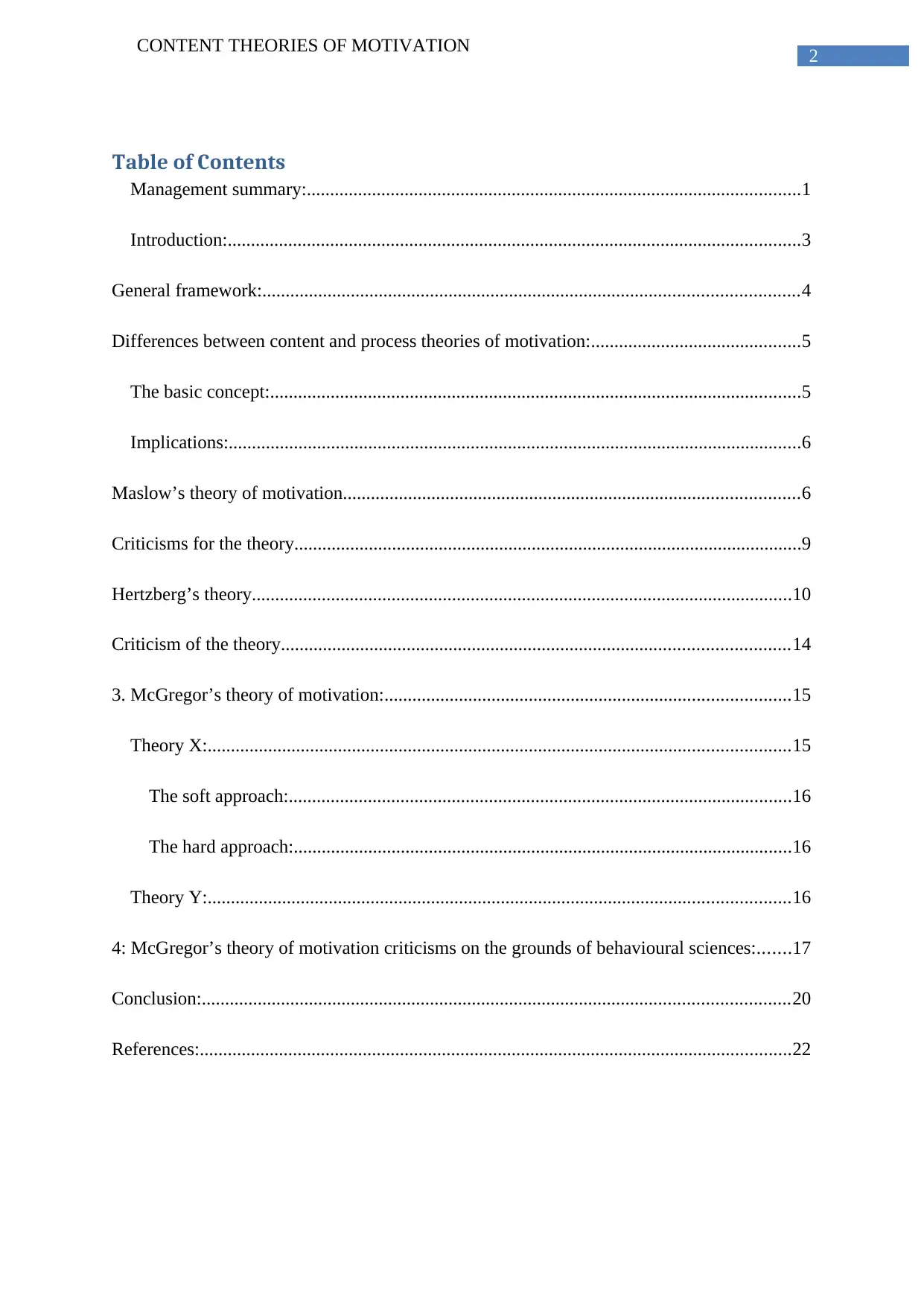
2
CONTENT THEORIES OF MOTIVATION
Table of Contents
Management summary:..........................................................................................................1
Introduction:...........................................................................................................................3
General framework:...................................................................................................................4
Differences between content and process theories of motivation:.............................................5
The basic concept:..................................................................................................................5
Implications:...........................................................................................................................6
Maslow’s theory of motivation..................................................................................................6
Criticisms for the theory.............................................................................................................9
Hertzberg’s theory....................................................................................................................10
Criticism of the theory.............................................................................................................14
3. McGregor’s theory of motivation:.......................................................................................15
Theory X:.............................................................................................................................15
The soft approach:............................................................................................................16
The hard approach:...........................................................................................................16
Theory Y:.............................................................................................................................16
4: McGregor’s theory of motivation criticisms on the grounds of behavioural sciences:.......17
Conclusion:..............................................................................................................................20
References:...............................................................................................................................22
CONTENT THEORIES OF MOTIVATION
Table of Contents
Management summary:..........................................................................................................1
Introduction:...........................................................................................................................3
General framework:...................................................................................................................4
Differences between content and process theories of motivation:.............................................5
The basic concept:..................................................................................................................5
Implications:...........................................................................................................................6
Maslow’s theory of motivation..................................................................................................6
Criticisms for the theory.............................................................................................................9
Hertzberg’s theory....................................................................................................................10
Criticism of the theory.............................................................................................................14
3. McGregor’s theory of motivation:.......................................................................................15
Theory X:.............................................................................................................................15
The soft approach:............................................................................................................16
The hard approach:...........................................................................................................16
Theory Y:.............................................................................................................................16
4: McGregor’s theory of motivation criticisms on the grounds of behavioural sciences:.......17
Conclusion:..............................................................................................................................20
References:...............................................................................................................................22
⊘ This is a preview!⊘
Do you want full access?
Subscribe today to unlock all pages.

Trusted by 1+ million students worldwide
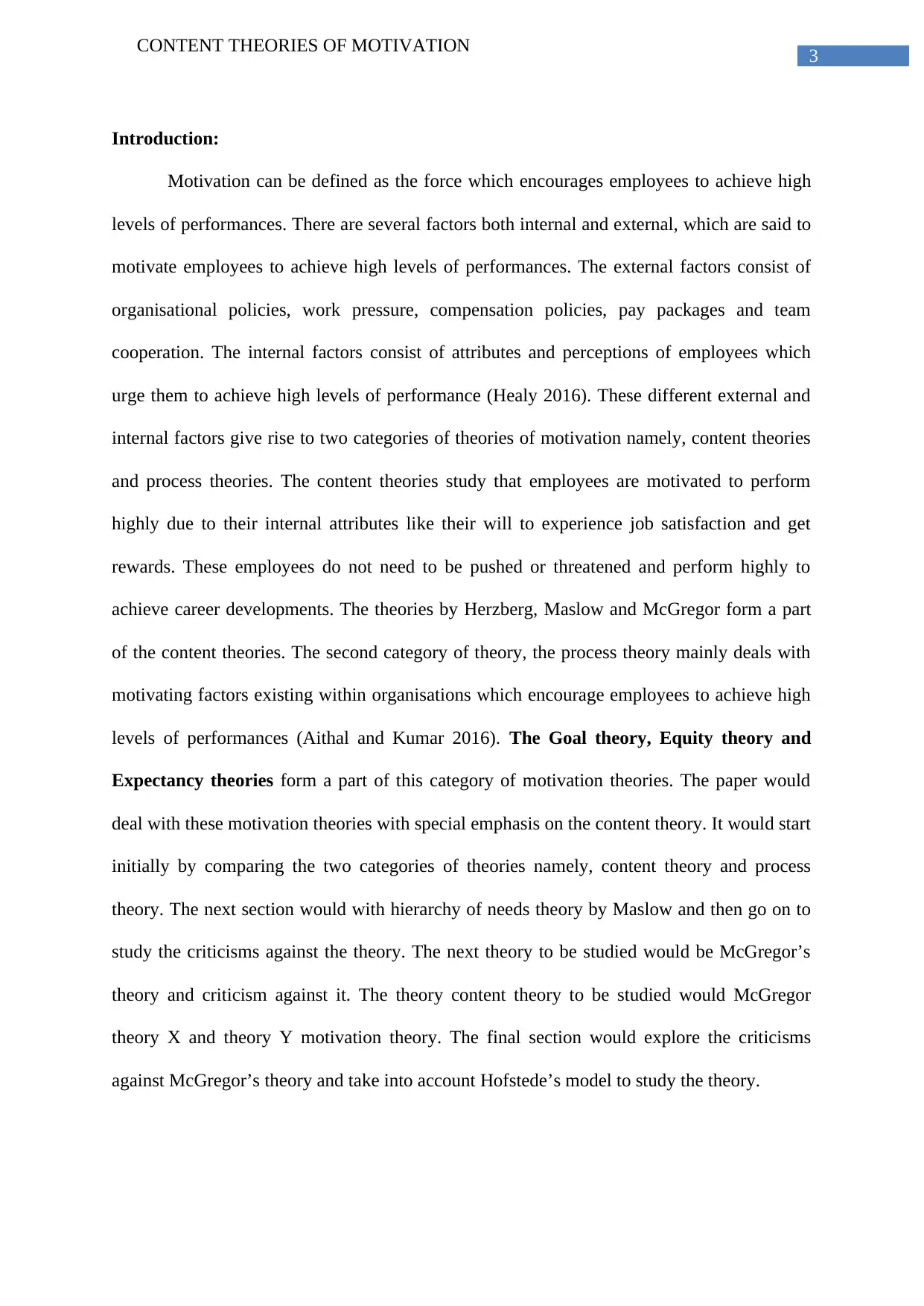
3
CONTENT THEORIES OF MOTIVATION
Introduction:
Motivation can be defined as the force which encourages employees to achieve high
levels of performances. There are several factors both internal and external, which are said to
motivate employees to achieve high levels of performances. The external factors consist of
organisational policies, work pressure, compensation policies, pay packages and team
cooperation. The internal factors consist of attributes and perceptions of employees which
urge them to achieve high levels of performance (Healy 2016). These different external and
internal factors give rise to two categories of theories of motivation namely, content theories
and process theories. The content theories study that employees are motivated to perform
highly due to their internal attributes like their will to experience job satisfaction and get
rewards. These employees do not need to be pushed or threatened and perform highly to
achieve career developments. The theories by Herzberg, Maslow and McGregor form a part
of the content theories. The second category of theory, the process theory mainly deals with
motivating factors existing within organisations which encourage employees to achieve high
levels of performances (Aithal and Kumar 2016). The Goal theory, Equity theory and
Expectancy theories form a part of this category of motivation theories. The paper would
deal with these motivation theories with special emphasis on the content theory. It would start
initially by comparing the two categories of theories namely, content theory and process
theory. The next section would with hierarchy of needs theory by Maslow and then go on to
study the criticisms against the theory. The next theory to be studied would be McGregor’s
theory and criticism against it. The theory content theory to be studied would McGregor
theory X and theory Y motivation theory. The final section would explore the criticisms
against McGregor’s theory and take into account Hofstede’s model to study the theory.
CONTENT THEORIES OF MOTIVATION
Introduction:
Motivation can be defined as the force which encourages employees to achieve high
levels of performances. There are several factors both internal and external, which are said to
motivate employees to achieve high levels of performances. The external factors consist of
organisational policies, work pressure, compensation policies, pay packages and team
cooperation. The internal factors consist of attributes and perceptions of employees which
urge them to achieve high levels of performance (Healy 2016). These different external and
internal factors give rise to two categories of theories of motivation namely, content theories
and process theories. The content theories study that employees are motivated to perform
highly due to their internal attributes like their will to experience job satisfaction and get
rewards. These employees do not need to be pushed or threatened and perform highly to
achieve career developments. The theories by Herzberg, Maslow and McGregor form a part
of the content theories. The second category of theory, the process theory mainly deals with
motivating factors existing within organisations which encourage employees to achieve high
levels of performances (Aithal and Kumar 2016). The Goal theory, Equity theory and
Expectancy theories form a part of this category of motivation theories. The paper would
deal with these motivation theories with special emphasis on the content theory. It would start
initially by comparing the two categories of theories namely, content theory and process
theory. The next section would with hierarchy of needs theory by Maslow and then go on to
study the criticisms against the theory. The next theory to be studied would be McGregor’s
theory and criticism against it. The theory content theory to be studied would McGregor
theory X and theory Y motivation theory. The final section would explore the criticisms
against McGregor’s theory and take into account Hofstede’s model to study the theory.
Paraphrase This Document
Need a fresh take? Get an instant paraphrase of this document with our AI Paraphraser
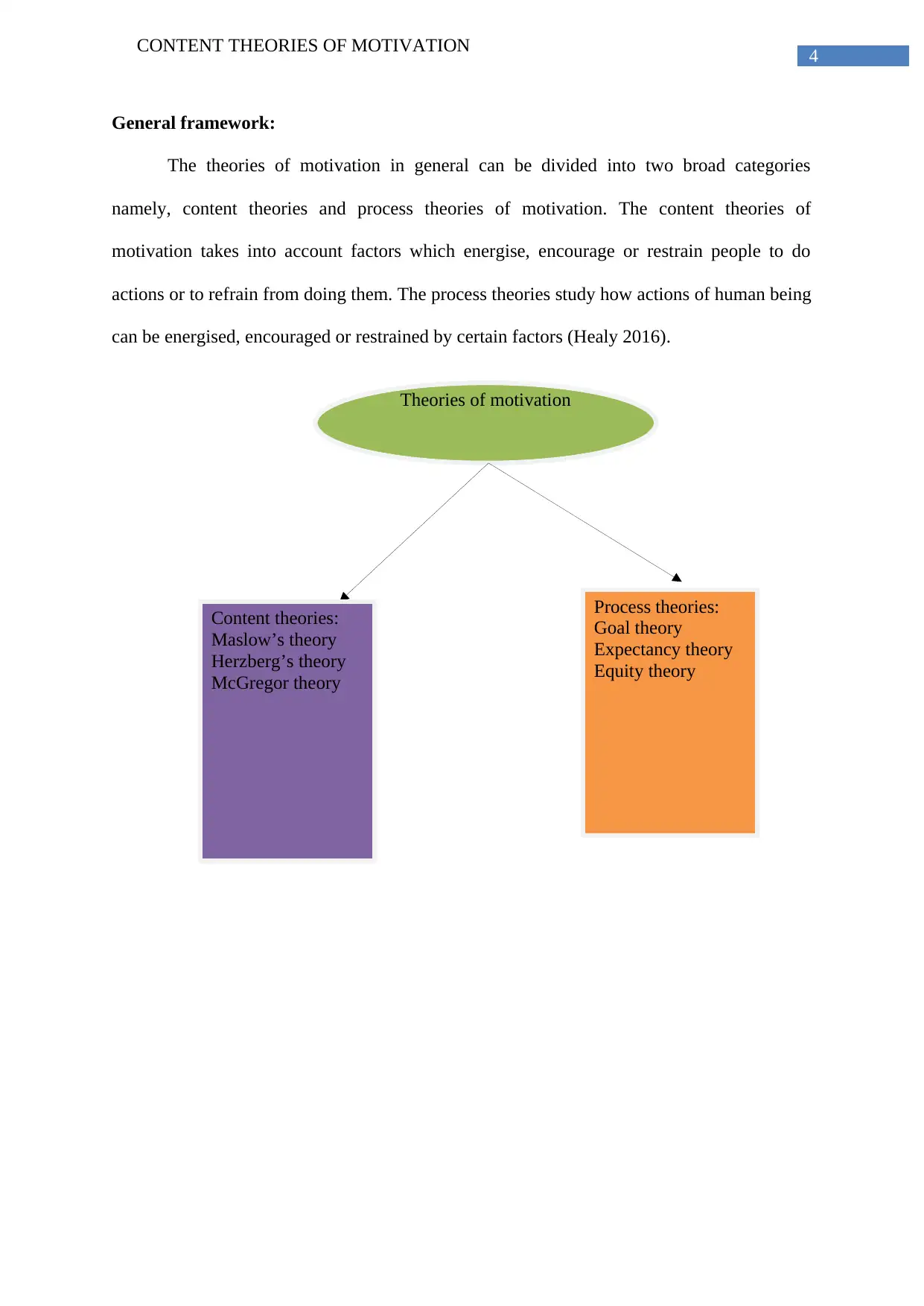
4
CONTENT THEORIES OF MOTIVATION
Theories of motivation
Content theories:
Maslow’s theory
Herzberg’s theory
McGregor theory
Process theories:
Goal theory
Expectancy theory
Equity theory
General framework:
The theories of motivation in general can be divided into two broad categories
namely, content theories and process theories of motivation. The content theories of
motivation takes into account factors which energise, encourage or restrain people to do
actions or to refrain from doing them. The process theories study how actions of human being
can be energised, encouraged or restrained by certain factors (Healy 2016).
CONTENT THEORIES OF MOTIVATION
Theories of motivation
Content theories:
Maslow’s theory
Herzberg’s theory
McGregor theory
Process theories:
Goal theory
Expectancy theory
Equity theory
General framework:
The theories of motivation in general can be divided into two broad categories
namely, content theories and process theories of motivation. The content theories of
motivation takes into account factors which energise, encourage or restrain people to do
actions or to refrain from doing them. The process theories study how actions of human being
can be energised, encouraged or restrained by certain factors (Healy 2016).
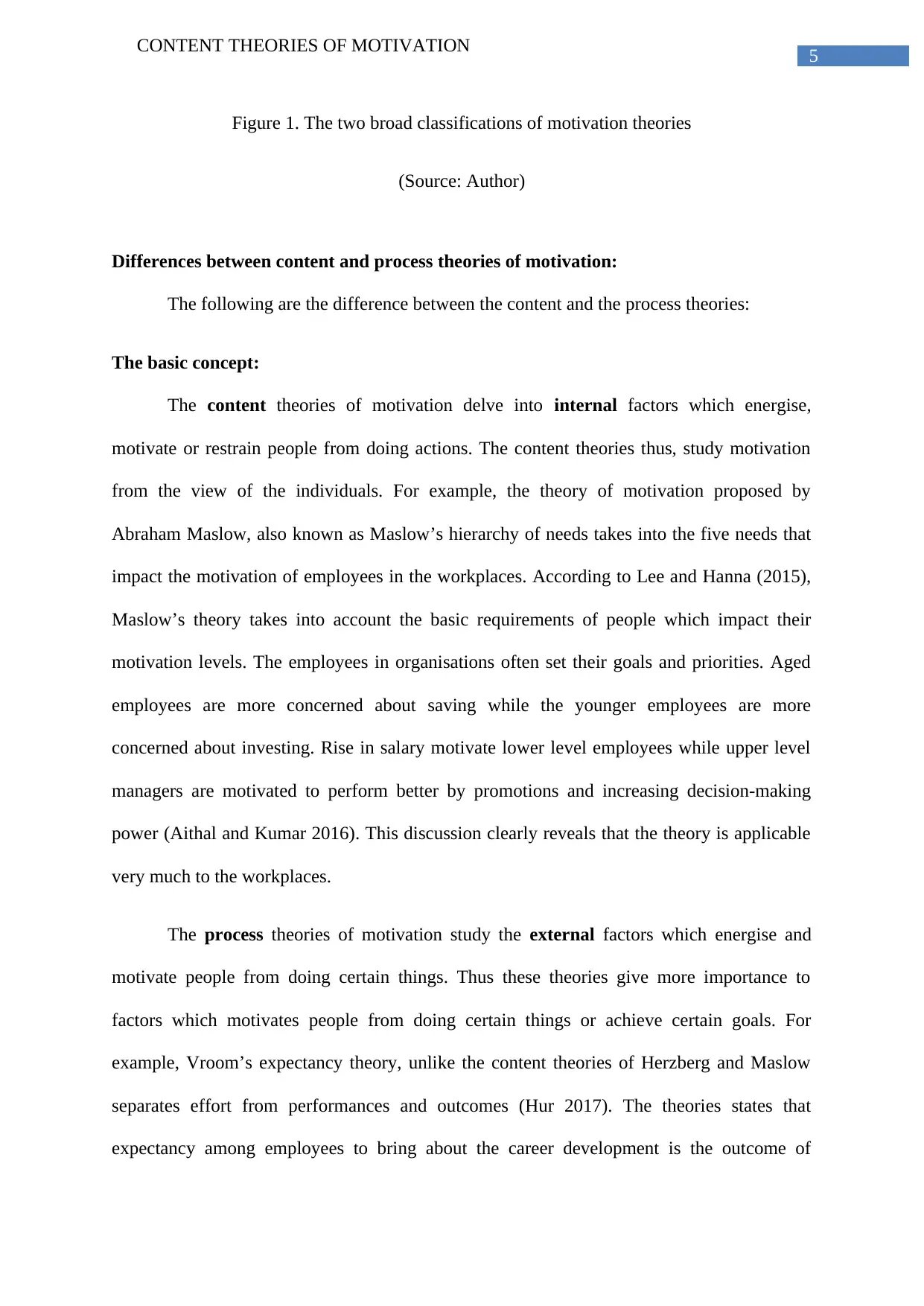
5
CONTENT THEORIES OF MOTIVATION
Figure 1. The two broad classifications of motivation theories
(Source: Author)
Differences between content and process theories of motivation:
The following are the difference between the content and the process theories:
The basic concept:
The content theories of motivation delve into internal factors which energise,
motivate or restrain people from doing actions. The content theories thus, study motivation
from the view of the individuals. For example, the theory of motivation proposed by
Abraham Maslow, also known as Maslow’s hierarchy of needs takes into the five needs that
impact the motivation of employees in the workplaces. According to Lee and Hanna (2015),
Maslow’s theory takes into account the basic requirements of people which impact their
motivation levels. The employees in organisations often set their goals and priorities. Aged
employees are more concerned about saving while the younger employees are more
concerned about investing. Rise in salary motivate lower level employees while upper level
managers are motivated to perform better by promotions and increasing decision-making
power (Aithal and Kumar 2016). This discussion clearly reveals that the theory is applicable
very much to the workplaces.
The process theories of motivation study the external factors which energise and
motivate people from doing certain things. Thus these theories give more importance to
factors which motivates people from doing certain things or achieve certain goals. For
example, Vroom’s expectancy theory, unlike the content theories of Herzberg and Maslow
separates effort from performances and outcomes (Hur 2017). The theories states that
expectancy among employees to bring about the career development is the outcome of
CONTENT THEORIES OF MOTIVATION
Figure 1. The two broad classifications of motivation theories
(Source: Author)
Differences between content and process theories of motivation:
The following are the difference between the content and the process theories:
The basic concept:
The content theories of motivation delve into internal factors which energise,
motivate or restrain people from doing actions. The content theories thus, study motivation
from the view of the individuals. For example, the theory of motivation proposed by
Abraham Maslow, also known as Maslow’s hierarchy of needs takes into the five needs that
impact the motivation of employees in the workplaces. According to Lee and Hanna (2015),
Maslow’s theory takes into account the basic requirements of people which impact their
motivation levels. The employees in organisations often set their goals and priorities. Aged
employees are more concerned about saving while the younger employees are more
concerned about investing. Rise in salary motivate lower level employees while upper level
managers are motivated to perform better by promotions and increasing decision-making
power (Aithal and Kumar 2016). This discussion clearly reveals that the theory is applicable
very much to the workplaces.
The process theories of motivation study the external factors which energise and
motivate people from doing certain things. Thus these theories give more importance to
factors which motivates people from doing certain things or achieve certain goals. For
example, Vroom’s expectancy theory, unlike the content theories of Herzberg and Maslow
separates effort from performances and outcomes (Hur 2017). The theories states that
expectancy among employees to bring about the career development is the outcome of
⊘ This is a preview!⊘
Do you want full access?
Subscribe today to unlock all pages.

Trusted by 1+ million students worldwide
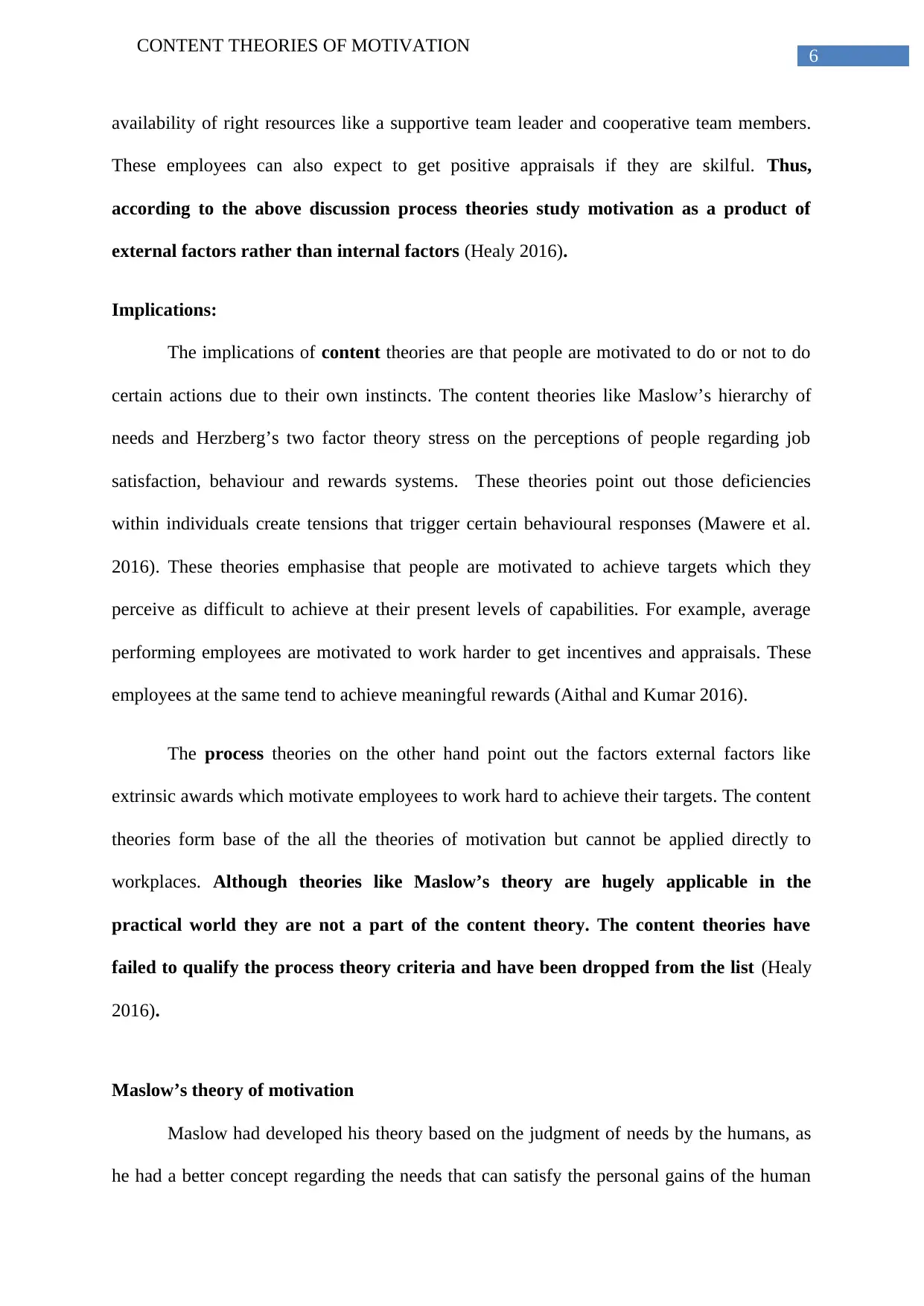
6
CONTENT THEORIES OF MOTIVATION
availability of right resources like a supportive team leader and cooperative team members.
These employees can also expect to get positive appraisals if they are skilful. Thus,
according to the above discussion process theories study motivation as a product of
external factors rather than internal factors (Healy 2016).
Implications:
The implications of content theories are that people are motivated to do or not to do
certain actions due to their own instincts. The content theories like Maslow’s hierarchy of
needs and Herzberg’s two factor theory stress on the perceptions of people regarding job
satisfaction, behaviour and rewards systems. These theories point out those deficiencies
within individuals create tensions that trigger certain behavioural responses (Mawere et al.
2016). These theories emphasise that people are motivated to achieve targets which they
perceive as difficult to achieve at their present levels of capabilities. For example, average
performing employees are motivated to work harder to get incentives and appraisals. These
employees at the same tend to achieve meaningful rewards (Aithal and Kumar 2016).
The process theories on the other hand point out the factors external factors like
extrinsic awards which motivate employees to work hard to achieve their targets. The content
theories form base of the all the theories of motivation but cannot be applied directly to
workplaces. Although theories like Maslow’s theory are hugely applicable in the
practical world they are not a part of the content theory. The content theories have
failed to qualify the process theory criteria and have been dropped from the list (Healy
2016).
Maslow’s theory of motivation
Maslow had developed his theory based on the judgment of needs by the humans, as
he had a better concept regarding the needs that can satisfy the personal gains of the human
CONTENT THEORIES OF MOTIVATION
availability of right resources like a supportive team leader and cooperative team members.
These employees can also expect to get positive appraisals if they are skilful. Thus,
according to the above discussion process theories study motivation as a product of
external factors rather than internal factors (Healy 2016).
Implications:
The implications of content theories are that people are motivated to do or not to do
certain actions due to their own instincts. The content theories like Maslow’s hierarchy of
needs and Herzberg’s two factor theory stress on the perceptions of people regarding job
satisfaction, behaviour and rewards systems. These theories point out those deficiencies
within individuals create tensions that trigger certain behavioural responses (Mawere et al.
2016). These theories emphasise that people are motivated to achieve targets which they
perceive as difficult to achieve at their present levels of capabilities. For example, average
performing employees are motivated to work harder to get incentives and appraisals. These
employees at the same tend to achieve meaningful rewards (Aithal and Kumar 2016).
The process theories on the other hand point out the factors external factors like
extrinsic awards which motivate employees to work hard to achieve their targets. The content
theories form base of the all the theories of motivation but cannot be applied directly to
workplaces. Although theories like Maslow’s theory are hugely applicable in the
practical world they are not a part of the content theory. The content theories have
failed to qualify the process theory criteria and have been dropped from the list (Healy
2016).
Maslow’s theory of motivation
Maslow had developed his theory based on the judgment of needs by the humans, as
he had a better concept regarding the needs that can satisfy the personal gains of the human
Paraphrase This Document
Need a fresh take? Get an instant paraphrase of this document with our AI Paraphraser
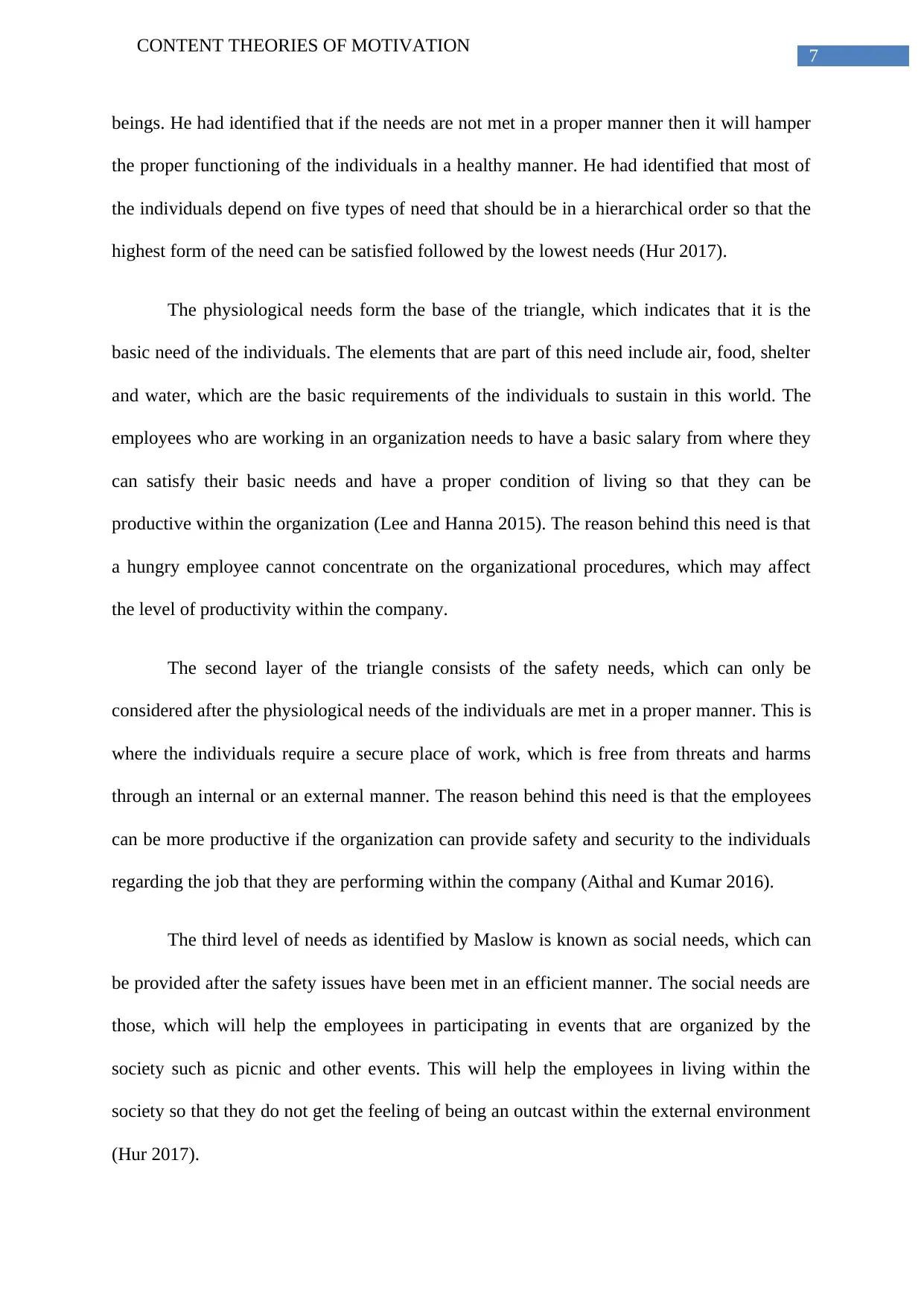
7
CONTENT THEORIES OF MOTIVATION
beings. He had identified that if the needs are not met in a proper manner then it will hamper
the proper functioning of the individuals in a healthy manner. He had identified that most of
the individuals depend on five types of need that should be in a hierarchical order so that the
highest form of the need can be satisfied followed by the lowest needs (Hur 2017).
The physiological needs form the base of the triangle, which indicates that it is the
basic need of the individuals. The elements that are part of this need include air, food, shelter
and water, which are the basic requirements of the individuals to sustain in this world. The
employees who are working in an organization needs to have a basic salary from where they
can satisfy their basic needs and have a proper condition of living so that they can be
productive within the organization (Lee and Hanna 2015). The reason behind this need is that
a hungry employee cannot concentrate on the organizational procedures, which may affect
the level of productivity within the company.
The second layer of the triangle consists of the safety needs, which can only be
considered after the physiological needs of the individuals are met in a proper manner. This is
where the individuals require a secure place of work, which is free from threats and harms
through an internal or an external manner. The reason behind this need is that the employees
can be more productive if the organization can provide safety and security to the individuals
regarding the job that they are performing within the company (Aithal and Kumar 2016).
The third level of needs as identified by Maslow is known as social needs, which can
be provided after the safety issues have been met in an efficient manner. The social needs are
those, which will help the employees in participating in events that are organized by the
society such as picnic and other events. This will help the employees in living within the
society so that they do not get the feeling of being an outcast within the external environment
(Hur 2017).
CONTENT THEORIES OF MOTIVATION
beings. He had identified that if the needs are not met in a proper manner then it will hamper
the proper functioning of the individuals in a healthy manner. He had identified that most of
the individuals depend on five types of need that should be in a hierarchical order so that the
highest form of the need can be satisfied followed by the lowest needs (Hur 2017).
The physiological needs form the base of the triangle, which indicates that it is the
basic need of the individuals. The elements that are part of this need include air, food, shelter
and water, which are the basic requirements of the individuals to sustain in this world. The
employees who are working in an organization needs to have a basic salary from where they
can satisfy their basic needs and have a proper condition of living so that they can be
productive within the organization (Lee and Hanna 2015). The reason behind this need is that
a hungry employee cannot concentrate on the organizational procedures, which may affect
the level of productivity within the company.
The second layer of the triangle consists of the safety needs, which can only be
considered after the physiological needs of the individuals are met in a proper manner. This is
where the individuals require a secure place of work, which is free from threats and harms
through an internal or an external manner. The reason behind this need is that the employees
can be more productive if the organization can provide safety and security to the individuals
regarding the job that they are performing within the company (Aithal and Kumar 2016).
The third level of needs as identified by Maslow is known as social needs, which can
be provided after the safety issues have been met in an efficient manner. The social needs are
those, which will help the employees in participating in events that are organized by the
society such as picnic and other events. This will help the employees in living within the
society so that they do not get the feeling of being an outcast within the external environment
(Hur 2017).
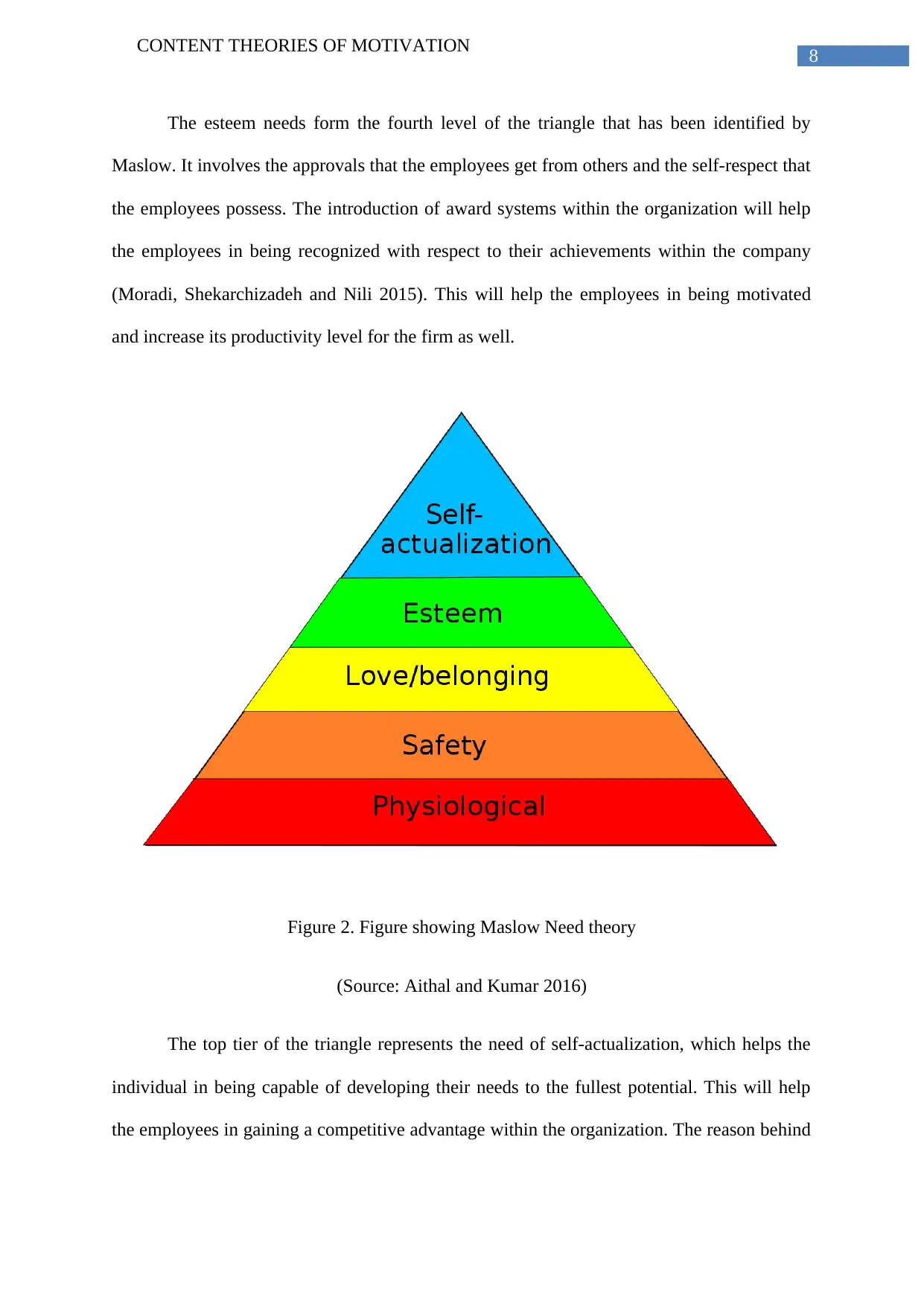
8
CONTENT THEORIES OF MOTIVATION
The esteem needs form the fourth level of the triangle that has been identified by
Maslow. It involves the approvals that the employees get from others and the self-respect that
the employees possess. The introduction of award systems within the organization will help
the employees in being recognized with respect to their achievements within the company
(Moradi, Shekarchizadeh and Nili 2015). This will help the employees in being motivated
and increase its productivity level for the firm as well.
Figure 2. Figure showing Maslow Need theory
(Source: Aithal and Kumar 2016)
The top tier of the triangle represents the need of self-actualization, which helps the
individual in being capable of developing their needs to the fullest potential. This will help
the employees in gaining a competitive advantage within the organization. The reason behind
CONTENT THEORIES OF MOTIVATION
The esteem needs form the fourth level of the triangle that has been identified by
Maslow. It involves the approvals that the employees get from others and the self-respect that
the employees possess. The introduction of award systems within the organization will help
the employees in being recognized with respect to their achievements within the company
(Moradi, Shekarchizadeh and Nili 2015). This will help the employees in being motivated
and increase its productivity level for the firm as well.
Figure 2. Figure showing Maslow Need theory
(Source: Aithal and Kumar 2016)
The top tier of the triangle represents the need of self-actualization, which helps the
individual in being capable of developing their needs to the fullest potential. This will help
the employees in gaining a competitive advantage within the organization. The reason behind
⊘ This is a preview!⊘
Do you want full access?
Subscribe today to unlock all pages.

Trusted by 1+ million students worldwide
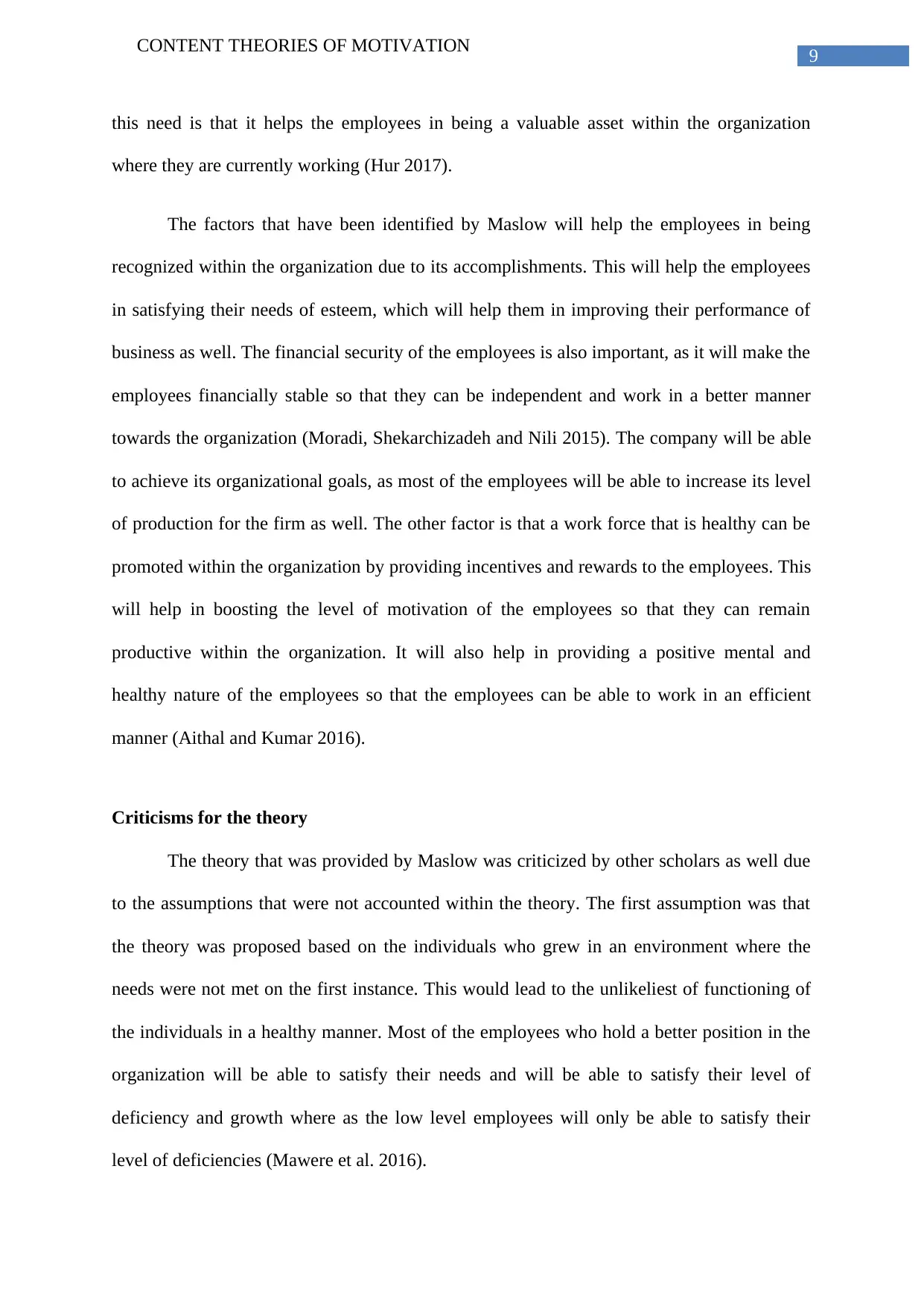
9
CONTENT THEORIES OF MOTIVATION
this need is that it helps the employees in being a valuable asset within the organization
where they are currently working (Hur 2017).
The factors that have been identified by Maslow will help the employees in being
recognized within the organization due to its accomplishments. This will help the employees
in satisfying their needs of esteem, which will help them in improving their performance of
business as well. The financial security of the employees is also important, as it will make the
employees financially stable so that they can be independent and work in a better manner
towards the organization (Moradi, Shekarchizadeh and Nili 2015). The company will be able
to achieve its organizational goals, as most of the employees will be able to increase its level
of production for the firm as well. The other factor is that a work force that is healthy can be
promoted within the organization by providing incentives and rewards to the employees. This
will help in boosting the level of motivation of the employees so that they can remain
productive within the organization. It will also help in providing a positive mental and
healthy nature of the employees so that the employees can be able to work in an efficient
manner (Aithal and Kumar 2016).
Criticisms for the theory
The theory that was provided by Maslow was criticized by other scholars as well due
to the assumptions that were not accounted within the theory. The first assumption was that
the theory was proposed based on the individuals who grew in an environment where the
needs were not met on the first instance. This would lead to the unlikeliest of functioning of
the individuals in a healthy manner. Most of the employees who hold a better position in the
organization will be able to satisfy their needs and will be able to satisfy their level of
deficiency and growth where as the low level employees will only be able to satisfy their
level of deficiencies (Mawere et al. 2016).
CONTENT THEORIES OF MOTIVATION
this need is that it helps the employees in being a valuable asset within the organization
where they are currently working (Hur 2017).
The factors that have been identified by Maslow will help the employees in being
recognized within the organization due to its accomplishments. This will help the employees
in satisfying their needs of esteem, which will help them in improving their performance of
business as well. The financial security of the employees is also important, as it will make the
employees financially stable so that they can be independent and work in a better manner
towards the organization (Moradi, Shekarchizadeh and Nili 2015). The company will be able
to achieve its organizational goals, as most of the employees will be able to increase its level
of production for the firm as well. The other factor is that a work force that is healthy can be
promoted within the organization by providing incentives and rewards to the employees. This
will help in boosting the level of motivation of the employees so that they can remain
productive within the organization. It will also help in providing a positive mental and
healthy nature of the employees so that the employees can be able to work in an efficient
manner (Aithal and Kumar 2016).
Criticisms for the theory
The theory that was provided by Maslow was criticized by other scholars as well due
to the assumptions that were not accounted within the theory. The first assumption was that
the theory was proposed based on the individuals who grew in an environment where the
needs were not met on the first instance. This would lead to the unlikeliest of functioning of
the individuals in a healthy manner. Most of the employees who hold a better position in the
organization will be able to satisfy their needs and will be able to satisfy their level of
deficiency and growth where as the low level employees will only be able to satisfy their
level of deficiencies (Mawere et al. 2016).
Paraphrase This Document
Need a fresh take? Get an instant paraphrase of this document with our AI Paraphraser
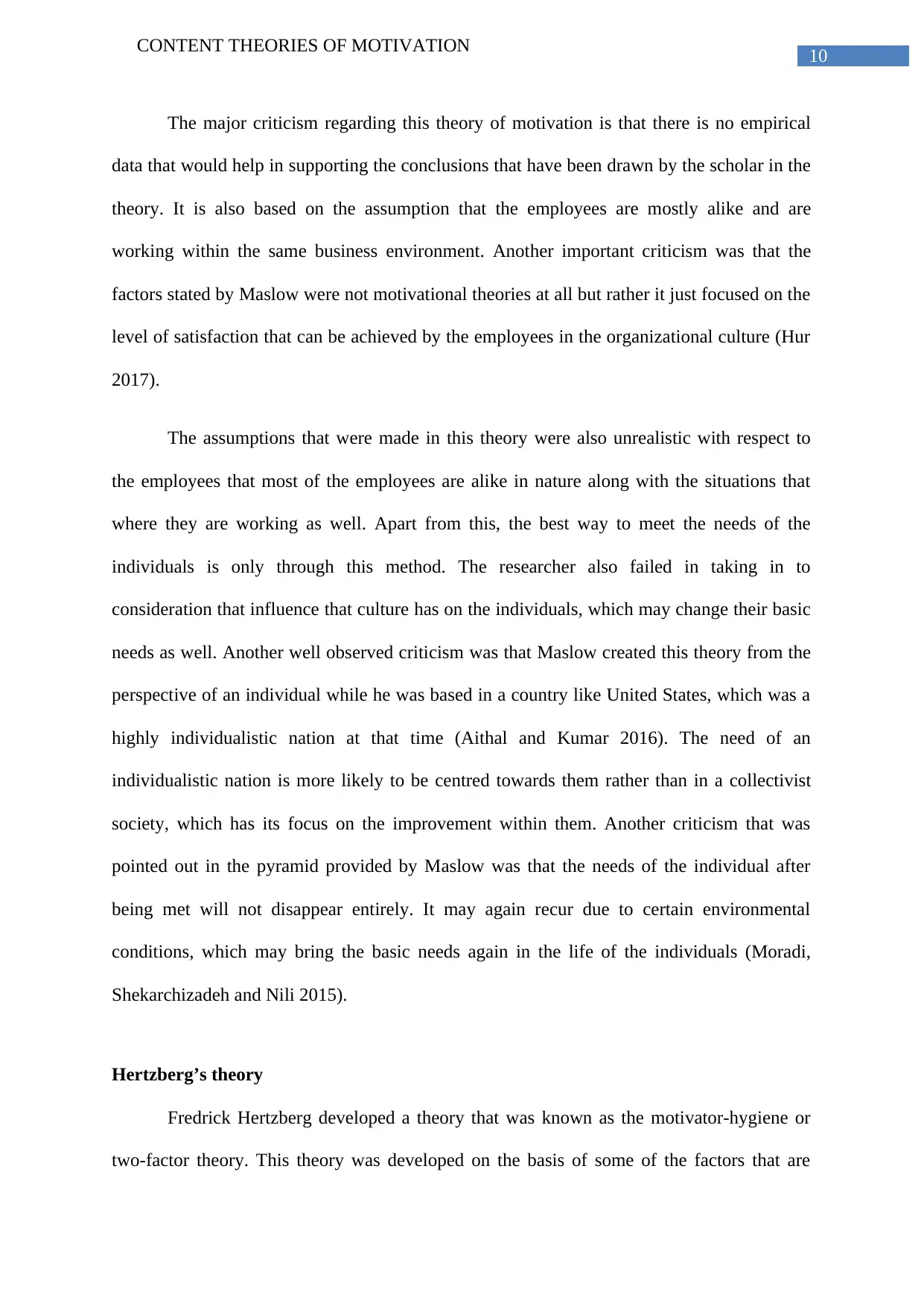
10
CONTENT THEORIES OF MOTIVATION
The major criticism regarding this theory of motivation is that there is no empirical
data that would help in supporting the conclusions that have been drawn by the scholar in the
theory. It is also based on the assumption that the employees are mostly alike and are
working within the same business environment. Another important criticism was that the
factors stated by Maslow were not motivational theories at all but rather it just focused on the
level of satisfaction that can be achieved by the employees in the organizational culture (Hur
2017).
The assumptions that were made in this theory were also unrealistic with respect to
the employees that most of the employees are alike in nature along with the situations that
where they are working as well. Apart from this, the best way to meet the needs of the
individuals is only through this method. The researcher also failed in taking in to
consideration that influence that culture has on the individuals, which may change their basic
needs as well. Another well observed criticism was that Maslow created this theory from the
perspective of an individual while he was based in a country like United States, which was a
highly individualistic nation at that time (Aithal and Kumar 2016). The need of an
individualistic nation is more likely to be centred towards them rather than in a collectivist
society, which has its focus on the improvement within them. Another criticism that was
pointed out in the pyramid provided by Maslow was that the needs of the individual after
being met will not disappear entirely. It may again recur due to certain environmental
conditions, which may bring the basic needs again in the life of the individuals (Moradi,
Shekarchizadeh and Nili 2015).
Hertzberg’s theory
Fredrick Hertzberg developed a theory that was known as the motivator-hygiene or
two-factor theory. This theory was developed on the basis of some of the factors that are
CONTENT THEORIES OF MOTIVATION
The major criticism regarding this theory of motivation is that there is no empirical
data that would help in supporting the conclusions that have been drawn by the scholar in the
theory. It is also based on the assumption that the employees are mostly alike and are
working within the same business environment. Another important criticism was that the
factors stated by Maslow were not motivational theories at all but rather it just focused on the
level of satisfaction that can be achieved by the employees in the organizational culture (Hur
2017).
The assumptions that were made in this theory were also unrealistic with respect to
the employees that most of the employees are alike in nature along with the situations that
where they are working as well. Apart from this, the best way to meet the needs of the
individuals is only through this method. The researcher also failed in taking in to
consideration that influence that culture has on the individuals, which may change their basic
needs as well. Another well observed criticism was that Maslow created this theory from the
perspective of an individual while he was based in a country like United States, which was a
highly individualistic nation at that time (Aithal and Kumar 2016). The need of an
individualistic nation is more likely to be centred towards them rather than in a collectivist
society, which has its focus on the improvement within them. Another criticism that was
pointed out in the pyramid provided by Maslow was that the needs of the individual after
being met will not disappear entirely. It may again recur due to certain environmental
conditions, which may bring the basic needs again in the life of the individuals (Moradi,
Shekarchizadeh and Nili 2015).
Hertzberg’s theory
Fredrick Hertzberg developed a theory that was known as the motivator-hygiene or
two-factor theory. This theory was developed on the basis of some of the factors that are
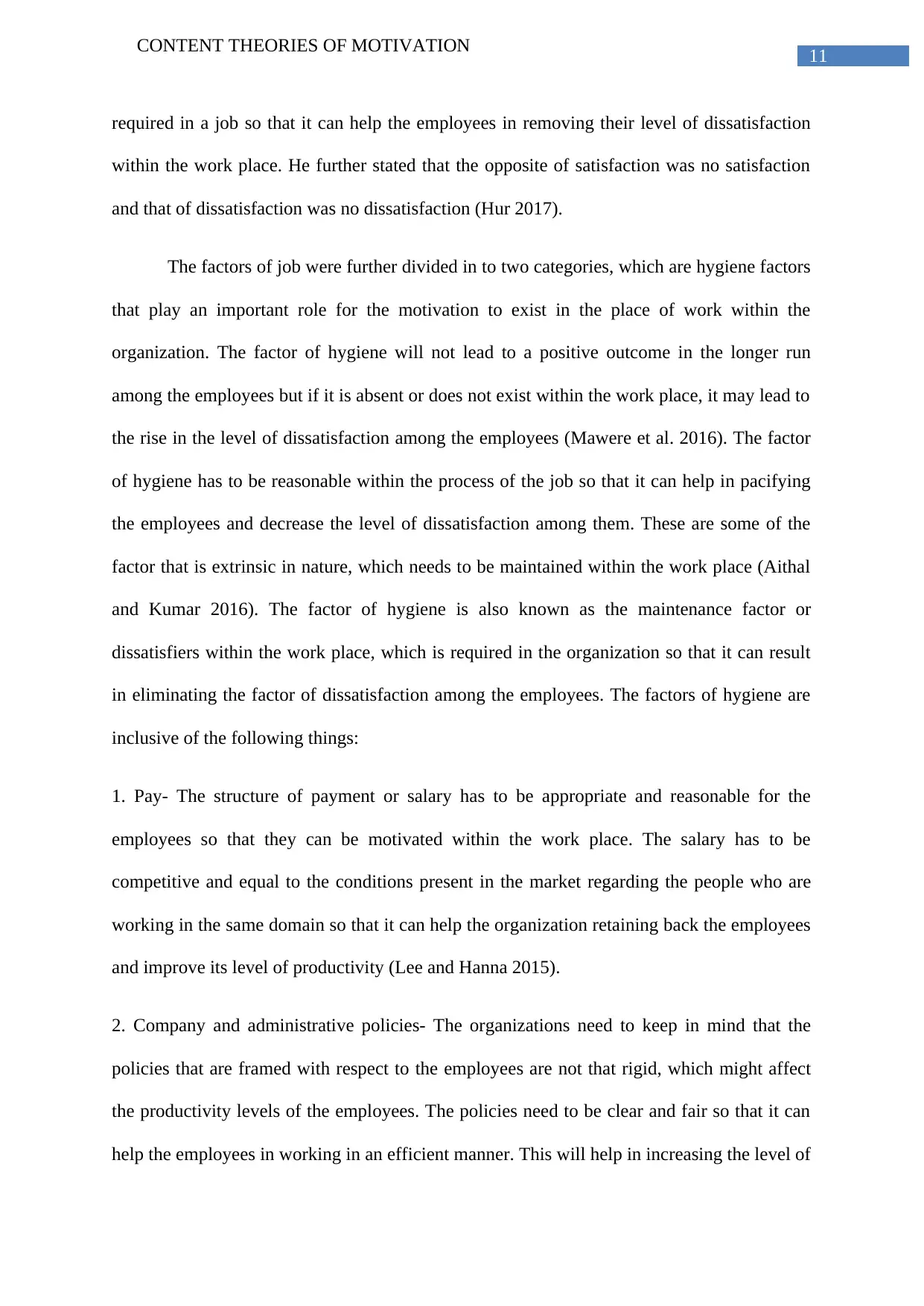
11
CONTENT THEORIES OF MOTIVATION
required in a job so that it can help the employees in removing their level of dissatisfaction
within the work place. He further stated that the opposite of satisfaction was no satisfaction
and that of dissatisfaction was no dissatisfaction (Hur 2017).
The factors of job were further divided in to two categories, which are hygiene factors
that play an important role for the motivation to exist in the place of work within the
organization. The factor of hygiene will not lead to a positive outcome in the longer run
among the employees but if it is absent or does not exist within the work place, it may lead to
the rise in the level of dissatisfaction among the employees (Mawere et al. 2016). The factor
of hygiene has to be reasonable within the process of the job so that it can help in pacifying
the employees and decrease the level of dissatisfaction among them. These are some of the
factor that is extrinsic in nature, which needs to be maintained within the work place (Aithal
and Kumar 2016). The factor of hygiene is also known as the maintenance factor or
dissatisfiers within the work place, which is required in the organization so that it can result
in eliminating the factor of dissatisfaction among the employees. The factors of hygiene are
inclusive of the following things:
1. Pay- The structure of payment or salary has to be appropriate and reasonable for the
employees so that they can be motivated within the work place. The salary has to be
competitive and equal to the conditions present in the market regarding the people who are
working in the same domain so that it can help the organization retaining back the employees
and improve its level of productivity (Lee and Hanna 2015).
2. Company and administrative policies- The organizations need to keep in mind that the
policies that are framed with respect to the employees are not that rigid, which might affect
the productivity levels of the employees. The policies need to be clear and fair so that it can
help the employees in working in an efficient manner. This will help in increasing the level of
CONTENT THEORIES OF MOTIVATION
required in a job so that it can help the employees in removing their level of dissatisfaction
within the work place. He further stated that the opposite of satisfaction was no satisfaction
and that of dissatisfaction was no dissatisfaction (Hur 2017).
The factors of job were further divided in to two categories, which are hygiene factors
that play an important role for the motivation to exist in the place of work within the
organization. The factor of hygiene will not lead to a positive outcome in the longer run
among the employees but if it is absent or does not exist within the work place, it may lead to
the rise in the level of dissatisfaction among the employees (Mawere et al. 2016). The factor
of hygiene has to be reasonable within the process of the job so that it can help in pacifying
the employees and decrease the level of dissatisfaction among them. These are some of the
factor that is extrinsic in nature, which needs to be maintained within the work place (Aithal
and Kumar 2016). The factor of hygiene is also known as the maintenance factor or
dissatisfiers within the work place, which is required in the organization so that it can result
in eliminating the factor of dissatisfaction among the employees. The factors of hygiene are
inclusive of the following things:
1. Pay- The structure of payment or salary has to be appropriate and reasonable for the
employees so that they can be motivated within the work place. The salary has to be
competitive and equal to the conditions present in the market regarding the people who are
working in the same domain so that it can help the organization retaining back the employees
and improve its level of productivity (Lee and Hanna 2015).
2. Company and administrative policies- The organizations need to keep in mind that the
policies that are framed with respect to the employees are not that rigid, which might affect
the productivity levels of the employees. The policies need to be clear and fair so that it can
help the employees in working in an efficient manner. This will help in increasing the level of
⊘ This is a preview!⊘
Do you want full access?
Subscribe today to unlock all pages.

Trusted by 1+ million students worldwide
1 out of 25
Related Documents
Your All-in-One AI-Powered Toolkit for Academic Success.
+13062052269
info@desklib.com
Available 24*7 on WhatsApp / Email
![[object Object]](/_next/static/media/star-bottom.7253800d.svg)
Unlock your academic potential
Copyright © 2020–2025 A2Z Services. All Rights Reserved. Developed and managed by ZUCOL.





